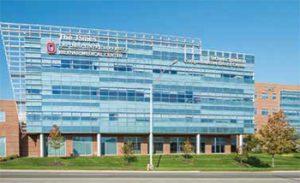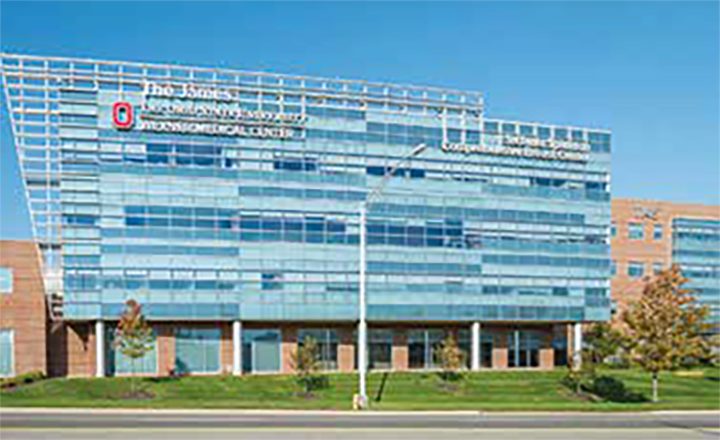When I, Caitlyn E. Hull, sought to become a women’s health nurse practitioner (WHNP), I had not considered the variety of roles that might be available. I had imagined myself working as a generalist in an obstetrics/gynecology (Ob/Gyn) private practice or federally funded clinic like many of my professors and preceptors, and I was thrilled with the possibilities that lay ahead of me in this field. When I was offered a position as a WHNP in surgical oncology at the Stefanie Spielman Comprehensive Breast Center (Photograph), which is affiliated with The Ohio State University Comprehensive Cancer Center – Arthur G. James Cancer Hospital (The James) and Richard J. Solove Research Institute, I had several questions and hesitations. I was curious about how my education and training would be utilized in breast oncology, particularly as a new NP.
Excluding non-melanoma skin cancers, breast cancer is the most common cancer in women in the United States; as of January 2018, more than 3.1 million U.S. women are breast cancer survivors.1 Owing to advances in the field of breast oncology over the past several decades, overall outcomes are much better today. The decreasing breast cancer mortality rate combined with a demographic shift toward an aging population has led to a large increase in the number of breast cancer survivors. In fact, these women represent 41% of all female cancer survivors.2
 The growing number of breast cancer survivors, whose healthcare needs become even more complex as they age, has presented an opportunity for WHNPs to play a more important role in their care. Physicians who work in the field of breast oncology have perceived an increased need to deliver survivorship care to their patients and are increasingly looking to NPs to address these specialized needs.3
The growing number of breast cancer survivors, whose healthcare needs become even more complex as they age, has presented an opportunity for WHNPs to play a more important role in their care. Physicians who work in the field of breast oncology have perceived an increased need to deliver survivorship care to their patients and are increasingly looking to NPs to address these specialized needs.3
During our initial interview, the surgeon who would become my primary collaborating physician said that, for him, working with a WHNP would enhance his ability to both run his practice and provide quality care to his patients. Because he needs to spend so much time in the operating room, the surgeon said that he, not to mention his patients, could benefit from having a WHNP work in the clinic, seeing patients either in collaboration with him or independently. In addition, he emphasized the meaningful provider–patient relationships that would evolve from caring for patients through their cancer journeys. He felt that a WHNP was particularly well equipped, by virtue of this provider’s educational background, experience, and nursing philosophy, to fill this role and achieve these goals.
I acknowledge that my entrance into breast oncology as a novice NP posed a steep learning curve. My entrance was facilitated by my orientation at the Stefanie Spielman Comprehensive Breast Center, which was structured to expose me to the evidence-based multidisciplinary team approach that is highly regarded within most healthcare delivery systems to improve patient outcomes. This orientation included observation experiences in the operating room and exposure to the various departments comprising the multidisciplinary team: reconstructive surgery, radiation oncology, medical oncology, radiology, and physical therapy. I spent a good deal of time reviewing breast pathology, as well as the National Comprehensive Cancer Network breast cancer guidelines that are the standard of care for practice in breast oncology.
My role in the surgical oncology clinic began by serving as an “extension” of the breast surgeon. During his three clinic days each week, I joined him in seeing both women with newly diagnosed breast cancer and breast cancer survivors coming in for follow-up visits. My main responsibility entailed performing a history and physical examination in women needing a breast biopsy or breast surgery. I also ordered and managed pre-operative laboratory testing and imaging, making referrals as needed, and I prepared patients for their breast procedures.
Over time, I have become even more deeply involved in the coordination of care of our patients, managing their treatment trajectory and seeing them in clinic for acute problems, most commonly postoperative complications, breast infections, and new breast lumps. In addition, I return patients’ phone calls; notify them of test results, including the pathology reports from biopsies and surgeries; and manage follow-up and case management problems as they arise.
Of note, our institution and physician colleagues, in addition to supporting WHNPs in their role in providing care for women with breast cancer, support WHNPs’ provision of care for men with benign and malignant breast conditions. Our standard-of-care arrangement states that we can care for men with breast diseases or conditions warranting our specialty expertise. Although breast cancer in men represents only 1% of all breast cancers, many of these men present at a more advanced stage of disease than do women.4 In 2018, approximately 2,500 men in the U.S. will be diagnosed with breast cancer and 500 will die of it.4 Utilization of WHNPs to see males with breast conditions enables us to differentiate benign breast conditions such as gynecomastia or breast abscess from breast cancer and expedite those with a malignancy to the appropriate care teams for treatment and support. Because male breast cancer is far less common than female breast cancer, I strongly encourage WHNPs to seek out continuing education (CE) resources to support their knowledge base and clinical experience in male breast cancer. In 2017, as an expert in our healthcare system because of my education and training, I organized a CE event for our advanced practice providers and registered nursing staff members that featured a journal club on the topic of male breast cancer to improve our awareness as an institution about caring for men with this disease.
Since I started in my position in 2012, the number of NPs in our organization has soared. We now have 23 NPs, including 7 WHNPs, caring for patients at the Stefanie Spielman Comprehensive Breast Center. The role that we play in caring for patients with breast cancer has expanded too. We now perform both independent and shared visits. In addition, the growing number of longterm breast cancer survivors has created a demand for WHNP-driven follow-up clinics to provide surveillance and to address the long-term physical and emotional sequelae of breast cancer treatments, as well as the increased need for survivorship care. Furthermore, WHNPs lead benign breast disease and high-risk breast disease clinics within the breast center.
In addition to the advancement of WHNPs within the breast center since I started in 2012, I have witnessed the implementation and accreditation of The James Oncology Advanced Practice Provider fellowship program. This 12-month, highly competitive program, initiated in 2013, offers NPs, including WHNPs, an opportunity to rotate within mentored subspecialty clinical experiences. These clinical experiences are supplemented by weekly educational sessions and training in evidence-based practice (EBP). This yearlong fellowship serves as a gateway for new WHNPs to enter the field of oncology at The James. WHNPs who have completed this program are now successfully caring for patients within the multiple specialty disciplines at The James, including gynecology/oncology, breast surgical/oncology, medical/oncology, and radiation/oncology.
Beyond the fellowship, The James offers its own version of a clinical ladder program to continue to enhance WHNPs’ professional development. This yearly opportunity allows all advanced practice providers to create five goals within the categories of leadership, education, clinical practice, EBP, and community service. Since its inception, this project has encouraged WHNPs to participate in numerous activities, including joining action committees, implementing unit improvement projects, presenting research projects, and providing women’s health services to underserved members of the community. This program has enriched my career by affording me the opportunity to guest-lecture on the WHNP role in survivorship care. My lectures are presented to graduate students in women’s health and nurse midwifery at our affiliated College of Nursing at The Ohio State University.
When I started my WHNP education, I did not imagine myself as a WHNP in breast oncology; now I am very proud to serve in this capacity. My WHNP education particularly my training in breast pathophysiology, breast health assessment and risk assessment, management of breast disorders, pharmacology, EBP, and patient centered care—provided the foundation I needed to navigate this specialty role. I have learned so much, both personally and professionally, since I started in my position, and I am humbled by the fact that I have a lot of learning left to do in this fast-paced, information-exploding specialty.
I admit that working in oncology can sometimes be emotionally taxing. However, the privilege of being a part of my patients’ journeys and helping them through some of the toughest moments of their lives is what makes my job so rewarding. I am passionate about taking care of these patients and I cherish the relationships I have built with them.
These connections are the threads that tie all of us together as WHNPs. Whether we work in a general Ob/Gyn practice or a breast cancer clinic, at the end of the day, caring for our patients is what we all have in common and why we keep doing what we do.
Caitlyn E. Hull is a women’s health nurse practitioner specialist at the Stefanie Spielman Comprehensive Breast Center and Randee L. Masciola is an Assistant Professor at The Ohio State University, College of Nursing, and an actively practicing women’s health nurse practitioner, both in Columbus, Ohio. The authors state that they do not have a financial interest in or other relationship with any commercial product named in this article.
References
- Breastcancer.org website. U.S. Breast Cancer Statistics. 2018.
- Ganz PA, Goodwin PJ. Breast cancer survivorship: where are we today? Adv Exp Med Biol. 2015;862:1-8.
- Friese C, Hawley S, Griggs J, et al. Employment of nurse practitioners and physician assistants in breast cancer care. J Oncol Pract. 2010;6(6):312-316.
- Giordano S. Breast cancer in men. N Engl J Med.2018;378(24):2311-2320.

